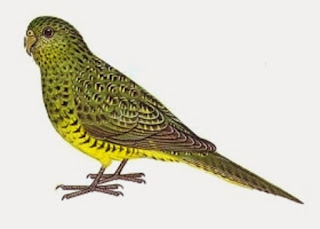 |
| Night Parrot |
Young discovered the Night Parrot on a remote grazing property south-west of Winton in far western Queensland following a six-year search. The area is sparsely vegetated gibber country interspersed by spinifex patches - some quite extensive - on the slopes and around the base of red rocky ridges, with denser vegetation and low trees in gullies and on ridge tops. It was in the general region that a dead Night Parrot was discovered in 2006 and relatively not too far removed - as the Night Parrot flies - from where a road-killed Night Parrot was found in 1990.
 |
| The mist-netted Night Parrot. Pic Rachel Barr |
Murphy and his assistant, Rachel Barr, managed to mist-net a Night Parrot last Easter. They attached a tiny radio transmitter to the bird before releasing it. The video of the bird disappearing into the spinifex is exquisite - a link to the video is here. Murphy's research was funded by Fortescue Metals as an offset for a company mining project in the Pilbara of Western Australia, where 3 Night Parrots were seen in 2005. Some doubt had been cast on that sighting, but the appearance and behaviour of the bird in the video is a good fit with the notes provided by the observers - especially the way the parrot moved across the ground. So Murphy's find may indirectly provide further evidence that a population of Night Parrots could be extant in the Pilbara as well as in south-west Queensland. Incidentally, Fortescue's funding for the Queensland research is scheduled to expire at the end of 2016.
 |
| Steve Murphy |
Until his success with the nets, Murphy had seen just one Night Parrot in the area: a bird that was probably sub-adult flew into view quickly in response to playback. Many other calling birds failed to respond to playback. Murphy has recorded several Night Parrot calls which demonstrate some variation in pitch and composition. An important question now is whether recordings of those calls will be distributed so that others can search for further populations. The present site in south-west Queensland understandably is not being revealed, but there is a strong case for recordings to be made available to assist in finding more Night Parrots.
 |
| Feral Cat caught on camera near Night Parrot site |
Bush Heritage Australia, which has an excellent reputation for acquiring and managing environmentally sensitive areas, is negotiating with the owners of the 1 million-hectare property to acquire about 5 per cent of the holding - 56,000 hectares including the known Night Parrot sites. The organisation hopes to raise $400,000 to fund the acquisition. Anyone wishing to assist in the acquisition can do so through this link.
A recovery team has been established comprising Murphy and experts from Bush Heritage Australia, Charles Darwin University, the Australian National University and the CSIRO. The federal and Queensland governments are both involved in planned management activities including the mapping of Night Parrot habitat, securing the site, mitigating wildfire risk and feral animal control.
John Young had once vowed to exclude government agencies from any role in protecting the area. Young had been offered on ongoing role in management but elected not to be a participant. Young was not involved in preparations for the latest announcement and in fact has distanced himself from the project in recent months. It is to Young's credit, however, that he recognised that the future of the bird lay beyond his limited resources and that the task required major input from government and non-government agencies alike. That's been the fortunate outcome, and the future of the Night Parrot is looking brighter as a result.
Thanks for the update Greg! This is far better news than I expected. Jeff Skevington
ReplyDeleteI saw it on Landline on Sunday ..... what a highlight when Steve released the bird and it scattered into the spinifex. Jude
ReplyDeleteThat is so awesome! These birds look like tiny kakapo!
ReplyDelete